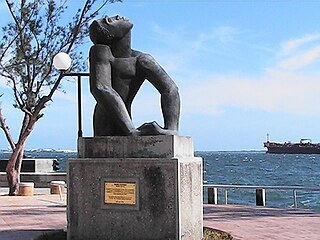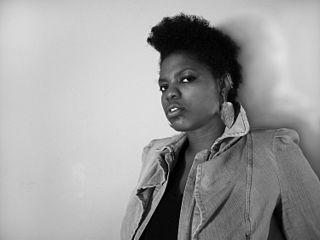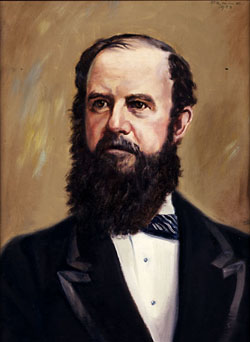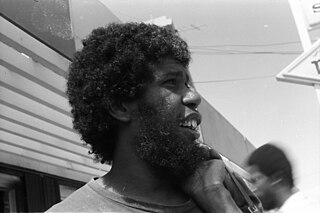
Visual Art [9m]

Keith Anthony Morrison, Commander of Distinction (C.D.), born May 20, 1942), is a Jamaican-born painter, printmaker, educator, critic, curator and administrator.

Ebony G. Patterson is a Jamaican-born visual artist and educator. She is known for her large and colorful tapestries created out of various materials such as, glitter, sequins, fabric, toys, beads, faux flowers, jewelry, and other embellishments. Her "Gangstas for Life series" of dancehall portraits, and her garden-inspired installations.
Christopher González OD was a Jamaican expressionistic sculptor and painter.

Jamaican art dates back to Jamaica's indigenous Taino Indians who created zemis, carvings of their gods, for ritual spiritual purposes. The demise of this culture after European colonisation heralded a new era of art production more closely related to traditional tastes in Europe, created by itinerant artists keen to return picturesque images of the "new world" to Europe. Foremost among these were Agostino Brunias, Philip Wickstead, James Hakewill and J. B. Kidd.
Albert Huie was a Jamaican painter.

Edna Manley College of the Visual and Performing Arts, formerly Jamaica School of Art and Crafts, is an art school in Kingston, Jamaica. In 1940, Edna Manley pioneered evening art classes at the Institute of Jamaica's Junior Centre but it was not until 1950 that the first formal arts school opened at the DaCosta Institute at 1 Central Avenue, Kingston Gardens. A number of leading Jamaican artists collaborated with Manley to open the first art school in Jamaica, including Albert Huie who became one of the tutors. 64 paying students enrolled in the first year and due to unexpected interest expanded the school at 11 North Street.
Ras Akyem is a Barbadian painter. A graduate of the Edna Manley School of Art in Jamaica, his work is heavily influenced by the Rastafari movement and bears resemblance to the paintings of Jean-Michel Basquiat. His work is frequently exhibited alongside that of Ras Ishi Butcher.
Henry Richmond Harold Fowler C.D., M.A. was a Jamaican educator, politician and cultural leader.

The Musgrave Medal is an annual award by the Institute of Jamaica in recognition of achievement in art, science, and literature. Originally conceived in 1889 and named in memory of Sir Anthony Musgrave, the founder of the Institute and the former Governor of Jamaica who had died the previous year, the medal was the first to be awarded in the Western Hemisphere.

Mallica Reynolds, OD, better known by the adopted name "Kapo", was a Jamaican artist and religious leader. Considered one of the greatest artists in Jamaica's "Intuitives" artistic movement, Kapo's religious beliefs were reflected in his work.

Kofi Kayiga, formerly known as Ricardo Wilkins, is a Jamaican-born artist and educator, who migrated to the US, after periods spent in the UK and Uganda. He has exhibited widely internationally and since the 1960s has taught fine art at various institutions, becoming a professor at the Massachusetts College of Art and Design (MassArt).
Petrona Morrison is a Jamaican sculptor and media artist. Her work is largely inspired by African art; she uses found objects in assemblages that have both personal and broader social themes.
Hope Brooks is a Jamaican painter. Many of her works consist of multiple panels, and are designed to be exhibited installation-style. Her works are mainly abstract, but many contain political themes as well.

Laura Facey CD is a Jamaican contemporary artist. She is best known for the monumental sculpture Redemption Song (2003), which serves as Jamaica's national monument to the Emancipation from Slavery.
Camille Chedda is a Jamaican visual artist and academic. She attended the Edna Manley College of the Visual and Performing Arts and the University of Massachusetts, Dartmouth. Chedda is a lecturer at the Edna Manley College of the Visual and Performing Art and Project Manager for the InPulse Collective, an artistic and social initiative to support urban Jamaican youth through the practice of visual arts in Kingston.
Cecil Archibald Baugh, was a Jamaican master potter and artist.

Dorothy Henriques-Wells was a Jamaican painter and art teacher. She is known for her sparse, vibrant watercolors depicting the plants and landscapes of Jamaica. She has works in the National Gallery of Jamaica and she received the Silver Musgrave Medal for Art in 1987. Henriques-Wells graduated from the Ontario College of Art in 1951, where she was the institution's first Black alumna. She taught art at Jamaican high schools and colleges for over two decades.

Afro-Atlantic Histories is the title of a touring art exhibition first held jointly at the São Paulo Museum of Art (MASP) and the Instituto Tomie Ohtake in Brazil in 2018. The exhibition is made up of artworks and historical artifacts from and about the African diaspora, specifically focusing "on the 'ebbs and flows' among Africa, Americas, Caribbean and also Europe." Built around the concept of histórias, a Portuguese term that can include fictional and non-fictional narratives, Afro-Atlantic Histories explores the artistic, political, social, and personal impacts and legacies of the Transatlantic slave trade. The exhibition has been hailed by critics as a landmark show of diasporic African art. Following the original 2018 exhibition, MASP partnered with the Museum of Fine Arts, Houston, and the National Gallery of Art in Washington, D.C., to bring a version of the exhibition to several museums in the United States from 2021 to 2024.










